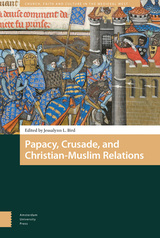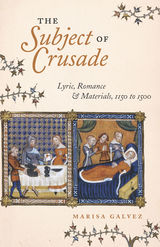2 books about Crusade

Papacy, Crusade, and Christian-Muslim Relations
Edited by Jessalynn
L. Bird
Amsterdam University Press, 2018
This book examines the role of the papacy and the crusade in the religious life of the late twelfth through late thirteenth centuries and beyond. Throughout the book, the contributors ask several important questions. Was Innocent III more theologian than lawyer-pope and how did his personal experience of earlier crusade campaigns inform his own vigorous promotion of the crusades? How did the outlook and policy of Honorius III differ from that of Innocent III in crucial areas including the promotion of multiple crusades (including the Fifth Crusade and the crusade of William of Montferrat) and how were both pope’s mindsets manifested in writings associated with them? What kind of men did Honorius III and Innocent III select to promote their plans for reform and crusade? How did the laity make their own mark on the crusade through participation in the peace movements which were so crucial to the stability in Europe essential for enabling crusaders to fulfill their vows abroad and through joining in the liturgical processions and prayers deemed essential for divine favor at home and abroad? Further essays explore the commemoration of crusade campaigns through the deliberate construction of physical and literary paths of remembrance. Yet while the enemy was often constructed in a deliberately polarizing fashion, did confessional differences really determine the way in which Latin crusaders and theirdescendants interacted with the Muslim world or did a more pragmatic position of ‘rough tolerance’ shape mundane activities including trade agreements and treaties?
[more]

The Subject of Crusade
Lyric, Romance, and Materials, 1150 to 1500
Marisa Galvez
University of Chicago Press, 2020
In the Middle Ages, religious crusaders took up arms, prayed, bade farewell to their families, and marched off to fight in holy wars. These Christian soldiers also created accounts of their lives in lyric poetry, putting words to the experience of personal sacrifice and the pious struggle associated with holy war. The crusaders affirmed their commitment to fighting to claim a distant land while revealing their feelings as they left behind their loved ones, homes, and earthly duties. Their poems and related visual works offer us insight into the crusaders’ lives and values at the boundaries of earthly and spiritual duties, body and soul, holy devotion and courtly love.
In The Subject of Crusade, Marisa Galvez offers a nuanced view of holy war and crusade poetry, reading these lyric works within a wider conversation with religion and culture. Arguing for an interdisciplinary treatment of crusade lyric, she shows how such poems are crucial for understanding the crusades as a complex cultural and historical phenomenon. Placing them in conversation with chronicles, knightly handbooks, artworks, and confessional and pastoral texts, she identifies a particular “crusade idiom” that emerged out of the conflict between pious and earthly duties. Galvez fashions an expanded understanding of the creative works made by crusaders to reveal their experiences, desires, ideologies, and reasons for taking up the cross.
In The Subject of Crusade, Marisa Galvez offers a nuanced view of holy war and crusade poetry, reading these lyric works within a wider conversation with religion and culture. Arguing for an interdisciplinary treatment of crusade lyric, she shows how such poems are crucial for understanding the crusades as a complex cultural and historical phenomenon. Placing them in conversation with chronicles, knightly handbooks, artworks, and confessional and pastoral texts, she identifies a particular “crusade idiom” that emerged out of the conflict between pious and earthly duties. Galvez fashions an expanded understanding of the creative works made by crusaders to reveal their experiences, desires, ideologies, and reasons for taking up the cross.
[more]
READERS
Browse our collection.
PUBLISHERS
See BiblioVault's publisher services.
STUDENT SERVICES
Files for college accessibility offices.
UChicago Accessibility Resources
home | accessibility | search | about | contact us
BiblioVault ® 2001 - 2024
The University of Chicago Press









